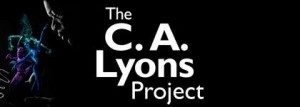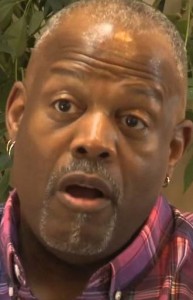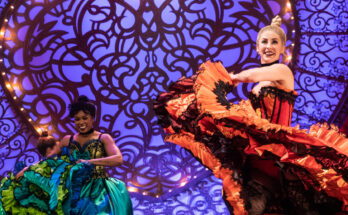 “The C.A. Lyons Project,” the winner of this year’s Alliance/Kendeda National Graduate Playwriting Competition, gets its world premiere Feb. 13-March 8 on the Alliance Theatre’s Hertz Stage.
“The C.A. Lyons Project,” the winner of this year’s Alliance/Kendeda National Graduate Playwriting Competition, gets its world premiere Feb. 13-March 8 on the Alliance Theatre’s Hertz Stage.
::
THE NEXT TIME YOU THINK it’s too late to do that one thing you vowed you would do someday, try saying this for inspiration: “Tsehaye Hébert.”
That’s: “suh-HI eh-BEAR.”
When many of her peers were throwing themselves retirement parties, Tsehaye Geralyn Hébert was filling out paperwork for grad school.
Then, in 2012, while attending the graduate playwriting program at the School of the Art Institute of Chicago, she got pneumonia so severe it led to a coma and paralysis. She could neither walk nor talk nor hold a pencil.
“The joke in my family,” Hébert says, “is that I had to finish my play.” Her physical therapist promised to “work the snot out of me. The first time I tried to stand up, I fainted.” But eventually she could walk six feet on the treadmill, then 12, then 24, and more each day.

HEBERT, PLAYWRIGHT-IN-RESIDENCE at Chicago State University as well as a longtime community arts activist and writing teacher, sees her life as “epic.” She has won recognition for earlier plays, but the one she had to finish is The C.A. Lyons Project, winner of the 2015 Alliance/Kendeda National Graduate Playwriting Competition. The piece began as “a whole bunch of thoughts and scraps of stuff” relating to her experiences on the black dance scene as AIDS took hold.
Over the years, whenever she had an idea for her someday play, Hébert would scribble it down and toss it into a box. “I carried that box around for years,” she says. A graduate school adviser gave her the courage finally to tackle its contents.
A native of Baton Rouge, La., Hébert considers herself mightily influenced by the land of gumbo, Mardi Gras, storytelling “and ritual, always ritual, and always live music.” She went to New York in the 1970s in search of “black dance beyond the cakewalk and tap dancing.” Ultimately, she was told that she was not right – that she was too old to dance, that she didn’t have the right body type.
She landed at Northwestern University to study film and theater “completely buying the story that dance was not in my future.” But one day she found herself in a place as vast as an armory, where an African dance class was underway.
“I literally started weeping when I walked in,” she says. “There were 200 people, from children to the elderly, all shapes and sizes imaginable. There were 25 drummers and the whole room was dancing – heavyset people, people with canes. It was a joyous community. I had come home.”
She became part of Chicago’s fledgling avant-garde black dance movement. AIDS, not yet identified, was already striking. Hébert knew dancers who died young, including a leading choreographic talent trying to finish a project.

“TSEHAYE AND I were both alive at the dawn of the 1980s as the world skittishly confronted the AIDS epidemic that would rob the world of many cultural giants,” says New York-based Kent Gash, the former Alliance associate artistic director who directs the multidisciplinary C.A. Lyons Project. “In the dance world alone, we lost brilliant black choreographers Billy Wilson, Ulysses Dove, the grand master Alvin Ailey and countless gifted performers. Who knows what extraordinary work they were yet to create?”
Set in the ’80s, the play centers on the founder of a dynamic African-American dance company who’s scrambling to choreograph while he’s gravely ill, and three female dancers, each of whom is affected by what’s happening to him.
In a fluid and lyrical narrative, Gash says Hébert explosively probes several themes: the life-and-death urgency prompted by the disease; the collision of black consciousness with sexual identity; class and politics; and the complex nuances of the human heart.
“You are going to get a ride when you see this show,” says Hébert. “Remember, I come from the land of Mardi Gras.”
While Angels in America and The Normal Heart are well-known plays dealing with AIDS, Gash calls The C.A. Lyons Project “more timely and necessary than ever before” because of its focus on black men, who continue to be affected by HIV/AIDS more than any other segment of the population.
Hébert still gets emotional when she thinks of the man who died in his mid-30s and inspired her title character.
“The grief at having lost him was so immense because he was the dance,” she says. “When you watched him dance, it was electrifying. I have always wanted the world to hear the story about how dance transformed my life and how it transformed the lives of others.”
Hébert has “played with this story in ways you cannot possibly imagine. First, I had to tell a good freaking story. I am trying to crack open the story and the stage at the same time. I want to open up the window wide enough so the audience can choose to climb through it, or they can sit back and peer through it and think about it.”
Most of all, she wants playgoers “to walk away a little differently than when they entered the theater.”
Perhaps some will even dance their way out the door.



